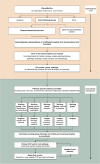Development and provider assessment of a new oncology network with care pathways for gastrointestinal cancer patients: the collaborative approach
- PMID: 40885947
- PMCID: PMC12398973
- DOI: 10.1186/s12885-025-14710-y
Development and provider assessment of a new oncology network with care pathways for gastrointestinal cancer patients: the collaborative approach
Abstract
Background: In an era of increasing demands on healthcare services, the development of regional oncology networks including care pathways may be instrumental to improve the efficiency and quality of care. However, developing such networks involving numerous stakeholders and hospitals is challenging as no templates exist. This study evaluates the development of a large regional network with the objective to provide a practical template.
Methods: A multicentre survey was conducted between October 1, 2024 and January 31, 2025. Clinicians from the departments of medical oncology, surgery, gastroenterology, pathology, radiology, nuclear medicine, and radiotherapy at the 13 hospitals in the OncoNoVo+ regional oncology network were invited. The survey included open-ended, multiple-choice, and slider questions (score range 0-100 on a visual analogue scale), focusing on baseline characteristics (n = 7), functioning of the network and care pathways (n = 16), and the development process of the care pathways (n = 6).
Results: Overall, 216 medical specialists, researchers, nurse specialists, and case-managers from 13 hospitals developed six care pathways (esophagogastric, pancreatic, small intestinal, rectal, liver, and biliary tract cancer). In the survey, 135 (63%) clinicians participated. Median scores of 75 or higher were observed in nine out of 11 satisfaction statements. Highest scores were observed for statements about the importance of regional care pathways, the recommendation of pathways outside the region, and the effectiveness of the OncoNoVo+ app (median, 85 [IQR, 75 to 97], 85 [75 to 99], and 84 [75 to 95], respectively). Mentioned 'essential factors for success' included coordination, collaboration, technology, and mutual respect. 'Improvement factors' included clearer implementation, better communication, regular updates, and equal involvement across hospitals and specialties.
Conclusion: The multicenter development and maintenance of regional care pathways for patients with gastrointestinal cancers within a regional oncology network seems feasible and effective with high satisfaction among participating hospitals. Implementation, communication, and equal involvement of centers and medical specialties deserve utmost attention.
Keywords: Cancer care pathways; Gastrointestinal cancer; Oncology networks; Pathway development; Regional collaboration.
© 2025. The Author(s).
Conflict of interest statement
Declarations. Competing interests: MIvanBH declares consultancies for Johnson and Johnson, Stryker, BBraun, Intuitive and Medtronic. MGB declares grants from Johnson and Johnson, Intuitive, Oncosil, and Medtronic for investigator-initiated studies. All fees paid to institution. All remaining authors have declared no conflicts of interest. Consent for publication: Consent for publication from all participants was obtained at completion of the survey. Ethics approval and consent to participate: Clinicians were informed about the goals of the survey, its duration and data storage. Participants were anonymized. Given the estimated minimal effect on participants and the absence of patient data collection, official approval by the Institutional Medical Ethics Committee of Amsterdam UMC was deemed unnecessary. The survey was performed in accordance with relevant guidelines and regulations. During review process: Britte ten Haaft, b.tenhaaft@amsterdamUMC.nl.
Figures



References
-
- Latenstein AEJ, Mackay TM, van der Geest LGM, et al. Effect of centralization and regionalization of pancreatic surgery on resection rates and survival. Br J Surg. 2021;108(7):826–33. - PubMed
Publication types
MeSH terms
LinkOut - more resources
Full Text Sources

